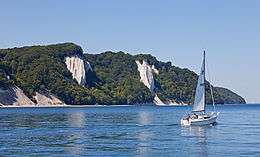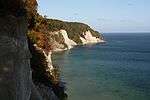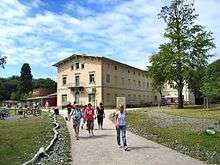Jasmund National Park
| Jasmund National Park | |
|---|---|
| Nationalpark Jasmund | |
|
IUCN category II (national park) | |
|
Cliffs and coastline in the national park | |
| Location |
|
| Nearest city | Sassnitz, Stralsund |
| Coordinates | 54°33′07″N 13°37′23″E / 54.552°N 13.623°ECoordinates: 54°33′07″N 13°37′23″E / 54.552°N 13.623°E |
| Area | 30 km2 (12 sq mi) |
| Established | 12 September 1990 |
| Primeval Beech Forests of the Carpathians and the Ancient Beech Forests of Germany | |
|---|---|
| Name as inscribed on the World Heritage List | |
 | |
| Type | Nature |
| Criteria | ix |
| Reference | 1133bis |
| UNESCO region | Europe |
| Inscription history | |
| Inscription | 2007 (31st Session) |
| Extensions | 2011 |
The Jasmund National Park (German: Nationalpark Jasmund) is a nature reserve on the Jasmund peninsula, in the northeast of Rügen island in Mecklenburg-Vorpommern, Germany. It is famous for containing the largest chalk cliffs in Germany, the Königsstuhl (German = "king's chair"). These cliffs are up to 161 m (528 ft) above the Baltic Sea. The beech forests behind the cliffs are also part of the national park.
Consisting of only 30 km2 (12 sq mi), this is the smallest national park in Germany. The park was founded in 1990 by the last government of East Germany (GDR) prior to the German reunification.
On June 25, 2011 the beech forest in the park was added to UNESCO World Heritage Site as an extension of the Primeval Beech Forests of the Carpathians and the Ancient Beech Forests of Germany.
Chalk cliffs
The chalk cliffs face constant erosion. With every storm, parts of the cliffs fall, including rocks and fossils of sponges, oysters and sea urchins.
The most majestic part of the cliffs is the Königsstuhl (English: king's chair) which stands at 118 m (387 ft). One of the most scenic and best known of the chalk outcrops, the Wissower Klinken, collapsed into the Baltic Sea on February 24, 2005, in a landslide caused by spring-thaw weather conditions.
Flora and fauna
Because of the special geological characteristics of the Jasmund National Park, it is home to many rare plants and animals.
In the woods of the Stubnitz, behind the cliffs, there are numerous water-filled dells and hollows, most of which came into existence as ice-age dead-ice holes. A wide range of plants are found in this area, for example, black alder, European crab apple, wild service tree, yew and orchids (like the Cypripedium calceolus).
A variety of birds live in the park: white-tailed eagle, kingfisher, house martin and the peregrine falcon.
Visitor management
Since its creation in 1934, the Jasmund National Park has attracted hundreds of thousands of visitors annually. One of the main tasks of the National Park Authority is to ensure that the diverse habitats of the park remain largely undisturbed, whilst still allowing visitors an insight into the nature of the region. In March 2004, the visitor centre, the Königsstuhl National Park Centre, was opened.
Gallery
 The Königsstuhl (King's Chair)
The Königsstuhl (King's Chair) The Königsstuhl,
The Königsstuhl,
view from the south- Victoria-Sicht (Victoria's View) and Königsstuhl from above
 Victoria-Sicht and Königsstuhl from the Baltic Sea
Victoria-Sicht and Königsstuhl from the Baltic Sea View down the white cliffs
View down the white cliffs The chalk cliffs
The chalk cliffs Stubbenkammer
Stubbenkammer Wissower Klinken
Wissower Klinken
(April 2004) Wissower Klinken
Wissower Klinken
(August 2005) Victoria-Sicht (Victoria's View)
Victoria-Sicht (Victoria's View) Black alder swamp
Black alder swamp Unfossilised sea urchin
Unfossilised sea urchin
External links
| Wikimedia Commons has media related to Nationalpark Jasmund. |
-
 Jasmund National Park travel guide from Wikivoyage
Jasmund National Park travel guide from Wikivoyage - Jasmund National Park pictures and information about the chalk cliffs (German)
- Official site (German)
- Photos of the park's beech forests (English)

